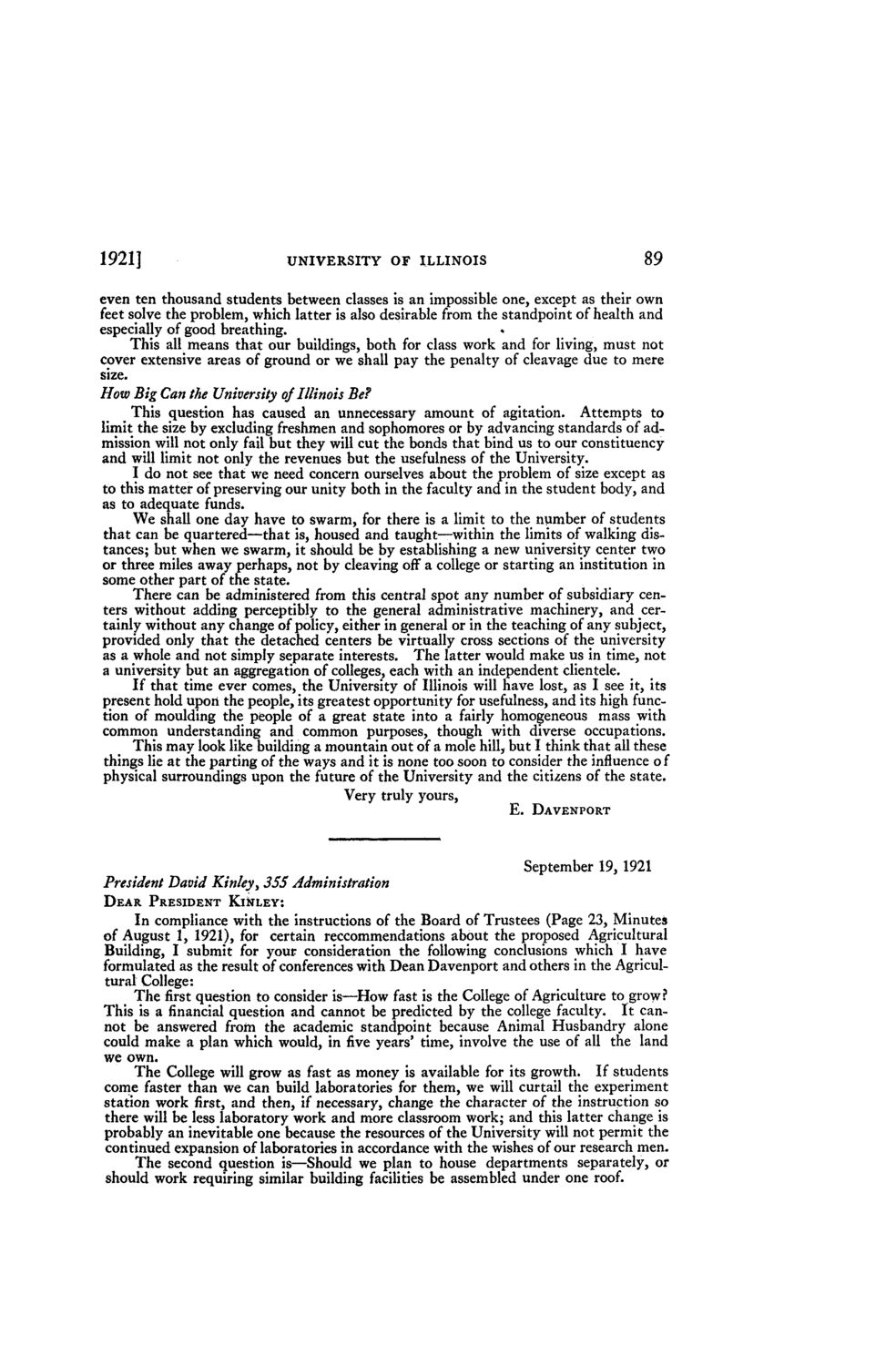| |
| |
Caption: Board of Trustees Minutes - 1922
This is a reduced-resolution page image for fast online browsing.

EXTRACTED TEXT FROM PAGE:
1921] UNIVERSITY OF ILLINOIS 89 even ten thousand students between classes is an impossible one, except as their own feet solve the problem, which latter is also desirable from the standpoint of health and especially of good breathing. This all means that our buildings, both for class work and for living, must not cover extensive areas of ground or we shall pay the penalty of cleavage due to mere size. How Big Can the University of Illinois Be? This question has caused an unnecessary amount of agitation. Attempts to limit the size by excluding freshmen and sophomores or by advancing standards of admission will not only fail but they will cut the bonds that bind us to our constituency and will limit not only the revenues but the usefulness of the University. I do not see that we need concern ourselves about the problem of size except as to this matter of preserving our unity both in the faculty and in the student body, and as to adequate funds. We shall one day have to swarm, for there is a limit to the number of students that can be quartered—that is, housed and taught—within the limits of walking distances; but when we swarm, it should be by establishing a new university center two or three miles away perhaps, not by cleaving off a college or starting an institution in some other part of the state. There can be administered from this central spot any number of subsidiary centers without adding perceptibly to the general administrative machinery, and certainly without any change of policy, either in general or in the teaching of any subject, provided only that the detached centers be virtually cross sections of the university as a whole and not simply separate interests. The latter would make us in time, not a university but an aggregation of colleges, each with an independent clientele. If that time ever comes, the University of Illinois will have lost, as I see it, its present hold upoii the people, its greatest opportunity for usefulness, and its high function of moulding the people of a great state into a fairly homogeneous mass with common understanding and common purposes, though with diverse occupations. This may look like building a mountain out of a mole hill, but I think that all these things lie at the parting of the ways and it is none too soon to consider the influence o f physical surroundings upon the future of the University and the citizens of the state. Very truly yours, E. DAVENPORT September 19, 1921 President David Kinley, 355 Administration DEAR PRESIDENT KINLEY: In compliance with the instructions of the Board of Trustees (Page 23, Minutes of August 1, 1921), for certain reccommendations about the proposed Agricultural Building, I submit for your consideration the following conclusions which I have formulated as the result of conferences with Dean Davenport and others in the Agricultural College: The first question to consider is—How fast is the College of Agriculture to grow? This is a financial question and cannot be predicted by the college faculty. It cannot be answered from the academic standpoint because Animal Husbandry alone could make a plan which would, in five years' time, involve the use of all the land we own. The College will grow as fast as money is available for its growth. If students come faster than we can build laboratories for them, we will curtail the experiment station work first, and then, if necessary, change the character of the instruction so there will be less laboratory work and more classroom work; and this latter change is probably an inevitable one because the resources of the University will not permit the continued expansion of laboratories in accordance with the wishes of our research men. The second question is—Should we plan to house departments separately, or should work requiring similar building facilities be assembled under one roof.
| |